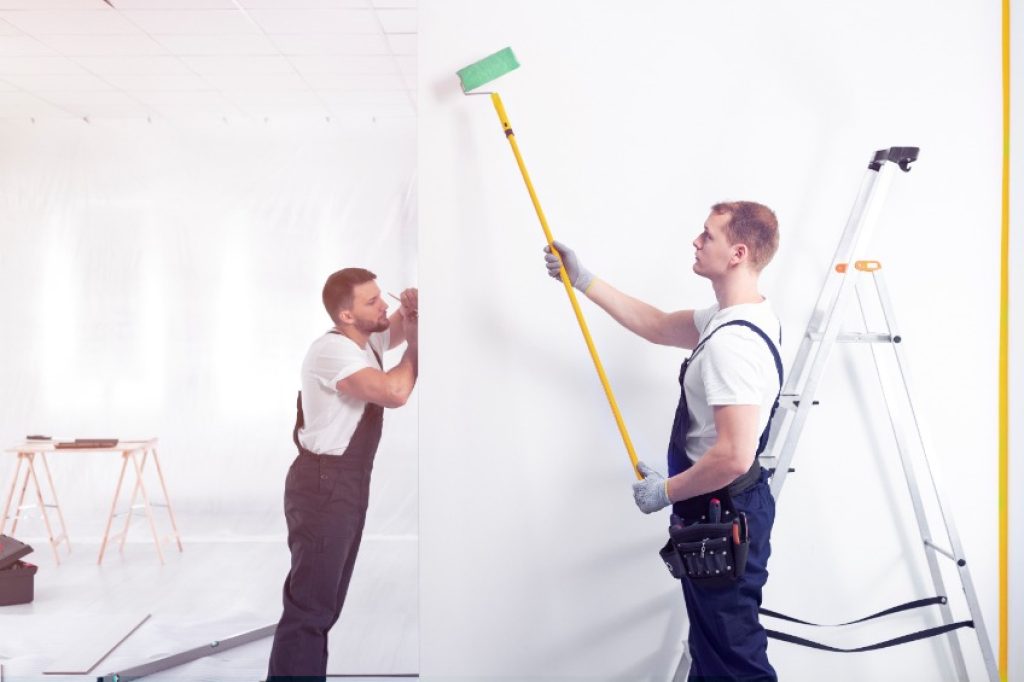Top 9 painters risks
Painters are essential to creating a pleasant living space. However, it is important that painters understand the potential risks associated with their work in order to keep themselves safe from harm. By taking precautions such as using the correct safety equipment, following safety regulations, and understanding the health hazards involved.

1. Slips, trips, and falls
Slips and trips when working on ladders and scaffolding. To prevent these, you should use the appropriate safety equipment and ensure that the floors are clean and dry before starting any painting or decorating job. You should also wear slip-resistant shoes to help prevent slips and falls.

2. Chemical burns
Serious injury and illness when exposed to hazardous chemicals during their work. These range from paint fumes, solvents and cleaning materials to more serious hazards such as lead dust. Prolonged exposure to these can cause skin irritation, breathing problems, chemical burns, cancer and other severe health conditions. To reduce the risk of exposure it is important that workers use
Protective equipment such as gloves, face masks and eye protection when handling hazardous materials. In some cases, it may be necessary to use respiratory protective equipment such as respirators or air filtering systems. Employers should provide comprehensive training on the safe use of chemicals and products used in the workplace.

3. Eye injuries
Eye injuries from dust, paint splashes and flying particles. They must wear protective eye wear when working with hazardous substances. Acute injuries can be caused by foreign bodies in the eye, such as dust or metal particles, which can cause irritation, inflammation or infection. Contracting diseases is also a risk for painters due to exposure to potentially harmful substances.
Inhalation of vapours and dusts, particularly when using spray paints, can cause breathing problems such as asthma or lung irritation. Skin contact with solvents used in paint thinning and stripping operations can cause skin damage, irritation or even burns if protective clothing isn’t worn.
Painters must also be aware of the possible dangers posed by lead-based paint, which can cause health problems if not handled correctly. The use of personal protection equipment and regular ventilating is necessary when using such products.
4. Respiratory problems
Developing respiratory problems from working in dusty and poorly ventilated environments, even if the dust is only present for a short period of time. Prolonged exposure to dust can irritate the eyes, nose and throat leading to coughing, wheezing and sneezing.
If painters are exposed to certain chemicals used in aerosols or paint, such as isocyanates and solvents, they may be at risk of developing asthma. Inhalation of certain chemicals can also damage the liver and kidneys over time.
It is important for painters to wear appropriate protective equipment when working in dusty or poorly ventilated environments. This includes a face mask, safety goggles and gloves to protect against the dust or harmful chemicals. It is also important to ensure that the workplace has adequate ventilation and that any dust or chemicals are regularly removed.
painters should be aware of their surroundings at all times in order to identify potential hazards. They should take regular breaks throughout the day, avoid any strenuous activities and work in well-lit environments. Furthermore, they should be aware of the safety guidelines and regulations relating to Painters.
5. Poisoning
Exposure to lead, solvents and other dangerous chemicals when working in older buildings or homes. Inhalation of these toxins can cause serious long-term health effects, such as impaired lung function, headaches, nausea, fatigue, reproductive problems and even cancer.
Workers who use a spray gun to apply paint are at greater risk than those using brushes and rollers because of the increased chance of inhaling airborne particles. It is also important to note that Some solvents and substances used in painting can be explosive, and are highly flammable.
6. Back injuries
Back injuries when carrying or raising heavy objects, such as painting equipment, ladders and other materials. To minimize the risk of back injury they should always use correct lifting techniques and not attempt to lift anything that is too heavy for them. They should also take regular breaks throughout their workday to help reduce fatigue which can lead to injury.
In addition to injury caused by lifting, painters are also at risk of developing musculoskeletal disorders (MSDs) due to the repetitive motions involved in painting.
These include tasks such as applying paint with a roller or brush, using a sanding machine, reaching up and down while painting walls and ceilings, or working in an awkward and/or uncomfortable position.
To reduce the risk of developing MSDs, painters should take regular breaks throughout their workday and use ergonomic tools and techniques to ensure that they are working in a comfortable position.
7. Electrical hazards
Electric shock if they work near exposed wires, such as when painting walls that contain electric sockets. They should be familiar with safety guidelines and electrical code requirements to ensure their protection. Additionally, before starting a job, it is important to check for any potential electrical hazards in the area. This could include frayed wires, worn out or damaged cords, or rusty outlets
8. Exposure to allergens
Exposure to allergens such as dust, paint fumes and solvents which can cause adverse health effects such as allergies or asthma. In order to reduce the risk of exposure, painters should always wear appropriate safety equipment, including gloves, masks and protective clothing.
They should also ensure that all paints and solvents used are properly labeled and stored correctly. Additionally, they should be aware of any local regulations or laws concerning the proper disposal and handling of hazardous materials. Understanding the potential health risks is an important part of being a successful painter and decorator.
9. Stress
A wide range of physical and mental health hazards, including musculoskeletal disorders, contact dermatitis, asthma and other respiratory illnesses, as well as fatigue and stress. To minimize such risks, employers should provide adequate safety equipment and clothing for painters; train them in safe work practices; ensure that their workplaces are free from dust and other hazardous substances; and make sure that they take regular breaks.
In addition, employers should provide suitable supervision for painters to ensure compliance with safety regulations. Finally, employers should offer psychological support to help workers cope with the stresses of the job. By taking these steps, employers can protect their workforce from the health risks associated with Painters.

FAQ:
What business insurance should painters have?
It is important for painters to carry appropriate business insurance which covers liability, property damage, workers’ compensation, and any other risks associated with their profession. They should also ensure that they are familiar with the safety regulations in their area, as this will help protect them from liability if an accident or injury occurs.
Additionally, they should consider purchasing insurance to cover any lost wages due to illness or injury that may occur while on the job.
What health risks are associated with Painters?
Health risks associated with Painters include musculoskeletal disorders, contact dermatitis, asthma and other respiratory illnesses, electric shock, exposure to allergens such as paint fumes or solvents, stress, fatigue, and back injuries from lifting heavy objects.
How can employers protect their painters from these health risks?
Employers should provide adequate safety equipment, train workers in safe work practices, ensure that workplaces are free from dust and other hazardous substances, take regular breaks, offer psychological support to help workers cope with job stressors, and provide suitable supervision.
What type of safety equipment should painters use?
Painters should wear appropriate safety equipment, including gloves, masks, and protective clothing to reduce the risk of exposure to allergens such as dust, paint fumes, or solvents. Additionally, they should be aware of any local regulations or laws concerning the proper disposal and handling of hazardous materials.
What ergonomic techniques can painters use to avoid musculoskeletal disorders?
To reduce the risk of developing MSDs, painters should take regular breaks throughout their workday and use ergonomic techniques such as posture improvement, stretching exercises and alternative tools.
Additionally, they should plan their work so that the heaviest or most difficult tasks are done first, when the worker is freshest. Employers can also help by providing appropriate safety equipment and clothing for painters.
Are there any electrical risks associated with Painters?
Yes, electric shock is one of the potential risks associated with Painters. To reduce this risk, workers should ensure that all electrical equipment is regularly checked and maintained according to manufacturer’s instructions.
Additionally, they should be aware of any local regulations or laws concerning the proper handling of electrical equipment.
What other potential risks should painters be aware of?
painters should also be aware of their own personal safety; they should never work alone, use ladders or scaffolding safely, and always wear the necessary protective clothing and equipment when working in hazardous environments or with potentially dangerous materials.
Additionally, they should be aware of any regulations or laws concerning their work and the proper disposal of hazardous materials.
What psychological support is available to painters?
Employers can provide psychological support to help workers cope with job stressors by offering counseling and other types of psychological assistance.
Additionally, employers should provide regular breaks throughout the workday to help workers manage their stress levels and stay focused on the task at hand.
What can employers do to ensure compliance with safety regulations?
Employers should ensure they are aware of all relevant local, state and federal regulations concerning Painters, and take steps to ensure their workers comply with these regulations.
Additionally, they should provide adequate safety equipment, training and supervision to help keep their painters safe.
Final thoughts
By understanding the potential risks involved in Painters, painters can better prepare themselves for the job. Taking proper safety precautions is essential in order to avoid injury or illness.
Employers should also ensure that their workers are properly trained and supplied with the necessary safety equipment. With the right preparation, painters can enjoy a safe and successful career.
Taking action to protect yourself and your coworkers is important for reducing the risks associated with Painters. Be sure to follow all safety guidelines

